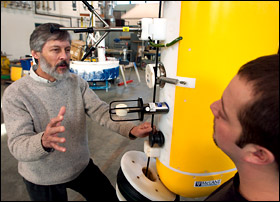
|
 |
Research > Research
Departments > Physical Oceanography
Physical Oceanography
Overview | Awards
& Recognition | Photos
 |
 |
| Nelson Hogg,
chair of the Physical Oceanography Department (left) and
Engineering Assistant Ryan Schrawder with a moored profiler
that Schrawder helped build. The moored profiler moves
up and down a mooring line to take continuous measurements
of water properties throughout the water column. (Photo
by Tom Kleindinst) |
The Physical Oceanography Department focuses on processes that
govern the properties and state of the ocean, and the oceanís
interactions with the solid Earth and atmosphere. The Department
has traditionally centered on making observations of the ocean,
but vigorous activities also include data interpretation, theory
development, numerical modeling, laboratory simulation, and
the development of new observational tools. This past year has
seen advances on all these fronts.
The Arctic Ocean is becoming a new focus for the Department.
In 2003 Bob Pickart returned to the Beaufort Sea to recover
and redeploy an array of seven moorings containing a newly developed
coastal profiler. It is a close cousin of the moored profiler
developed at WHOI, which travels up and down a steel cable anchored
to the seafloor, continuously measuring physical properties
throughout the water column. Bobís instruments performed exceptionally
well, and he now feels he understands the mechanism that generates
the active eddy field within the Beaufort Sea: a periodically
unstable current flowing along the seaís southern boundary.
Andrey Proshutinsky set moorings in the center of the Beaufort
Sea in 2003. He is testing his theory that the Beaufort Sea
acts as a flywheel that alternately stores and discharges fresh
water into the rest of the Arctic Ocean and, eventually, into
the North Atlantic, where the influx may affect ocean circulation
and climate.
Other scientists worked in the Antarctic (Bob Beardsley and
Breck Owens), off northwest Australia (Kip Shearman and Ken
Brink), and in the tropical Pacific (Bob Weller) and Atlantic
(Al Plueddemann). Both Al and Bob also participated in CBLAST
(Coupled Boundary Layers/Air-Sea Transfer), the large air-sea
interaction program off Marthaís Vineyard sponsored by the Office
of Naval Research (ONR). Using WHOIís newly launched remotely
operated vehicle Jason II, Mike McCartney and colleagues
recovered six moorings that had been stranded in the tropical
Atlantic for more than a year because of defective releases.
Dave Fratantoni and his fleet of underwater gliders successfully
participated in ONRís month-long Autonomous Ocean Sampling Network
project in Monterey Bay, California.
Two new members joined the scientific staff: Jason Goodman and
Jim Lerczak. Jasonís interests include global ocean-atmosphere
coupling, dynamics of the frozen seas of Europa (a moon of Jupiter),
and possible causes of Snowball Earth, a period 600 to 700 million
years ago when Earth was globally ice-covered. Jim works in
coastal and estuarine regions, investigating the physics of
tides and river outflow, and couplings between biology and physics
that affect larvae dispersal.
Bruce Warren retired in 2003 after a long and productive career.
He came to WHOI as an undergraduate during the summer of 1955
and was appointed to the scientific staff in 1963. For his many
contributions to physical oceanography, he will be awarded the
2004 Ewing Medal from the American Geophysical Union.
We were saddened by the death late in 2003 of Nick Fofonoff,
Scientist Emeritus, whose career also spanned many decades at
the Institution. Nick led efforts to develop and understand
current and water property measurements, both for the Department
and the field as a whole. Until shortly before his death, he
remained at work on a new idea for how thermodynamics might
determine the sharpness of the thermocline, the boundary layer
between lighter and denser water masses in the ocean.
—Nelson Hogg (nhogg@whoi.edu)
Department Chair
|
|
